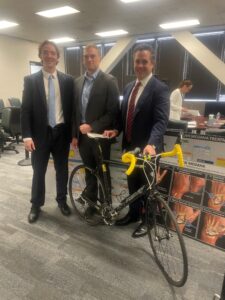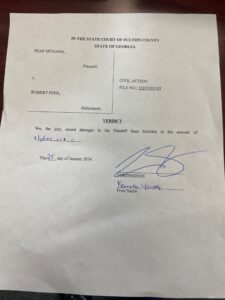On January 25, 2023, a Fulton County jury returned a verdict in favor of our client in the amount of $1,600,000.00. For three years our lawyers warned State Farm that a jury would return a verdict for over a million dollars. And for three years, just like insurance companies typically do, State Farm balked never offering more than $430,000.


You can learn more about the case by visiting this article 2 Bicycles Crashed. Fulton Jurors Awarded $1.6 Million | Daily Report (law.com)
- Summary of the case
- This was a case that arose from a bicycle on bicycle accident that occurred next to Piedmont Park along 10th Street in Midtown Atlanta on March 29, 2021. Our client, who was 30 at the time, was riding his bicycle in the bike lane when the defendant, who was the same age, was riding in the opposite direction in the car lane adjacent to the bicycle lane. The defendant suddenly cut right into our client’s bike lane causing the bicycles to strike one another. The collision knocked our client to the ground; he sustained injuries to both of his hands and wrists. He ultimately had surgeries and over 50 sessions of physical therapy. Those surgeries were by all accounts successful, however, we argued at trial that he continues to experience pain. He also aggravated an existing knee injury, but we strategically chose not to discuss the knee injury nor did we ask for reimbursement of any of his medical expenses. Instead, we focused our entire case on the pain he feels in his hands and wrists. For damages witnesses, we brought to testify three family members, two friends, the surgeon and the primary physical therapist via a medical report. We themed the case that “broken rules caused broken bones”. We kept repeating that no one chooses to give up the activities they love and that our client had good days and bad days but that his pain was still present some almost 3 years later.
- Three Days of Trial
- We could not have asked for a more attentive jury. Almost every juror took notes during the trial; most of them wrote down the numbers Darren asked for during the closing argument; and most of those we interviewed after the trial said they connected with our client. Our client is an extremely deserving young man who has his whole life ahead of him. This verdict of $1,600,000 will not undo the pain in his hands, but it will secure him a pain-free financial freedom. Our jury was comprised of 8 women and 4 men.
- One of the biggest litigation hurdles we had to overcome
- During voir dire (jury selection when 42 possible jurors are questioned before the 12 jurors are selected) one of the prospective jurors asked who pays for any compensation that’s awarded. Someone blurted out loud that the defendant would be the one paying–which was not true, it was his homeowner’s insurance that would pay–but because we could not explain it was homeowners insurance that would in fact pay the verdict–as Georgia law precludes us from ever mentioning the fact that insurance pays verdicts, not the defendants in the courtroom–we felt concerned how that would adversely influence the jurors in to not wanting to award a substantial verdict. Jurors intuitively think that auto insurance protects defendants in motor vehicle accidents, but here we had a bicycle on bicycle. None of the jurors had the faintest idea that homeowners insurance was in play. (How we found out that homeowners insurance applied in this particular case was we asked for the policies and read them cover to cover early on looking for any coverage that may apply.) When we interviewed jurors after the verdict was announced, they confirmed that there was serious concern about who would pay the verdict. They believed it would be the defendant personally. (Amazingly, we still won $1.6 million. Imagine how much we could have won had this been a car versus bicycle case as that would have left the jury thinking there’s car insurance!)
- Lawyers who try cases, remember this:
- You have to have a likable client who a jury will want to help. People want to help people they trust and like: You have to have both. We had one of those clients, plus he had great damages witnesses. We spent months preparing with our client. In addition, we brought in multiple forms of media to connect with the jurors: we used a lot of technology including a confidence monitor, and our own television in addition to the court television to show power point presentations. We also used an Ipevo to handwrite key words as each witness spoke so that the jury would hear and see the words being spoken. Before we got in to the substance of our direct, for each witness, we would hold up a “road map” which we drew ahead of time that looked like a simple road with exit signs, and tell the witness and jury where we were going and where we were headed. This was something unique that most lawyers do not do and it kept the jury interested and attentive. Audio and visual learning was our key. We used flip charts; and we had over a dozen boards on multiple tripods. We even had 3 magnetized boards made of different angles of the bicycle path and had custom made magnetic bicyclists so we could move them on the boards.
- Lastly, we wheeled in the bicycle that our client was riding on the day the accident that showed one of the handle bars damaged. Darren in his closing set up the courtroom almost theater style: the boards surrounded the television which was front and center displaying the power point presentation; with the bicycle leaning front and center propped up against the base of the television stand; flip chart on the far right where he wrote down the numbers for the verdict; and the enormous medical timeline visible enough that the jury could be overwhelmed just enough by remembering how long the recovery was.
- Visuals matter. Jurors want to see and hear the evidence. Gone are the days of a lawyer just walking up to the podium with a notebook. We never once stood behind the podium. We stayed right by the jury as best we could and had the witnesses look at the jury when they answered questions.
- Spend time mapping out your strategy. We took a big risk with this, but it paid off. We did not introduce the medical bills even though they were over $160,000. That was a big number that could have hurt us since we didn’t claim it, but we wanted to make the case about the pain, not the expenses. We did not want the jury to feel tied to that number when determining what the pain and suffering was worth. Instead we had our client on cross-examination say that he was there in court because his hands were still in pain almost three years later. It was a calculated risk because it meant we were foregoing a claim for medical expenses. But it paid off because the jury understood that they were in that room to deliver justice for the pain he feels, not the bills he’s paid.
